Diversity, Equity and Inclusion Strategic Plan
Introduction
For more than fifty years, Community College of Philadelphia has been a leader in the city of Philadelphia and a driving force in educational access and attainment for its citizens. During this period, the College has exhibited a strong commitment to diversity, equity, and inclusion in its efforts to address discrimination, inequality, injustice, and the lack of access in higher education.
This Diversity, Equity and Inclusion plan aligns with the College’s mission statement as follows:
Community College of Philadelphia is an open admission, associate-degree-granting institution, which provides access to higher education for all who may benefit. Its programs of study in the liberal arts and sciences, career technologies, and basic academic skills provide a coherent foundation for College transfer, employment, and lifelong learning. The College serves Philadelphia by preparing its students to be informed and concerned citizens, active participants in the cultural life of the city, and enabled to meet the changing needs of business, industry, and the professions. To help address broad economic, cultural and political concerns in the city and beyond, the College draws together students from a wide range of ages and backgrounds and seeks to provide the programs and support they need to achieve their goals.
Community College of Philadelphia seeks to create a caring environment, which is intellectually and culturally dynamic and encourages all students to achieve:
- Greater insight into their strengths, needs, and aspirations, and greater appreciation of their own cultural background and experience;
- Increased awareness and appreciation of a diverse world where all are interdependent;
- Heightened curiosity and active interest in intellectual questions and social issues;
- Improved ability to pursue paths of inquiry, to interpret and evaluate what is discovered, and to express reactions effectively;
- Self-fulfillment based on service to others, preparation for future work and study, and enjoyment of present challenges and accomplishments.
To strengthen the College’s Commitment to diversity, equity, and inclusion, the College has made this work its 6th Pillar in the College 2017-2025 Strategic Plan.
The 6th Pillar states:
Situated in the heart of the racially diverse and culturally vibrant city of Philadelphia, the College is comprised of a diverse group of students, faculty, staff, and administrators. As such, the College is committed to ensuring that diversity, equity and inclusion (DEI)is embedded in all aspects of college life, including admissions, the academic experience, employee recruitment and retention, and in its relationships with entities doing business with the College. Diversity is the presence of individuals from different backgrounds (ages, people with various abilities and disabilities, ethnicities, genders, gender identities, national origins, political affiliations, races, religions, sexual orientations, socio-economic statuses, and veterans) and experiences within the College community. Equity is the process of ensuring that processes and programs are impartial, fair and provide equal possible outcomes for all persons within the College community. Inclusion is the practice of ensuring that all who are part of the College community, including those from diverse groups and intersectional identities, feel supported, valued, respected and welcome. The College understands that its DEI pledge is honored when students and employees witness that the College exhibits this pledge not just through its words, but also its actions.
The College will undertake the continuous critical analysis of existing structures in all facets of the College, identify those that are inequitable on their face or in their application, and do the hard work necessary to dismantle those inequitable structures. The work of DEI is a continuum, and the College commits to an annual review and assessment through an equity lens of policies and procedures that affect student outcomes, employee hiring and retention, vendor proposals and agreements, and all other areas that may benefit.
Ultimately, this intentional focus will position the College to become an innovative leader in the city and nation in the area of DEI work by creating a safe space campus that values, promotes, and amplifies the experiences of those from traditionally underrepresented or marginalized groups in its curricula, programming, administrative policies, hiring practices, daily interactions, and activities. These concerted efforts will lead to increased student engagement, and improved retention and academic outcomes.
Strategic Directions
- Require all departments across the College community to create Diversity Plans that specifically address where diversity is lacking and include strategies on how each will increase, retain and support underrepresented employee groups in their departments, along with plans on how these strategies will be continually reviewed and assessed for effectiveness.
- Become an Anti-Racist College and fully implement anti-racist training for all administrators, staff and faculty.
- Implement College policies that promote equitable outcomes in the classroom and all other areas and aspects of the college experience, with the goal of increasing equitable graduation and pass rates for all students.
- Encourage and facilitate the use of diverse and inclusive course materials.
- Increase participation of minority, disabled, and women-owned suppliers to fulfill College’s procurement needs.
- Continue to develop and implement a comprehensive system of accountability and assessment around diversity, equity, and inclusion initiatives, practices and policies.
This Diversity, Equity and Inclusion Plan is the result of the collaborative efforts of the members of the President’s Diversity, Equity, and Inclusion Council. The Plan builds on and borrows from earlier efforts and strives to sustain and improve on our unwavering commitment to diversity, equity and inclusion. The Plan recognizes the interconnectedness of diversity and academic success, which is the foundation for the long-term success of our institution.
DEI Plan Goals [1]
Goal 1: Require all divisions/departments across the College community to create Diversity, Equity, and Inclusion Plans, unique to each division, that specifically identify gaps in diversity, equity, and inclusion and include strategies on how each will increase, retain and support underrepresented employee groups in their divisions/departments, along with plans on how these strategies will be continually reviewed and assessed for effectiveness.
Objective A: To have a diverse workforce at all levels in the College including faculty, administrators, and staff, which is reflective of the City and student body we serve.
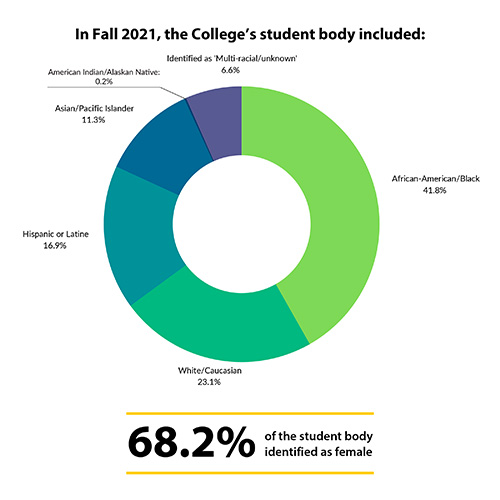 |
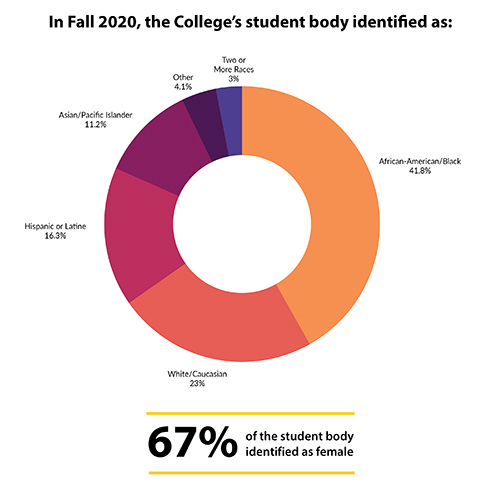 |
|
In Fall 2021, the College’s student body included: African-American/Black: 41.7% |
In Fall 2020, the College’s student body identified as: 41% of students identified as African-American/Black |
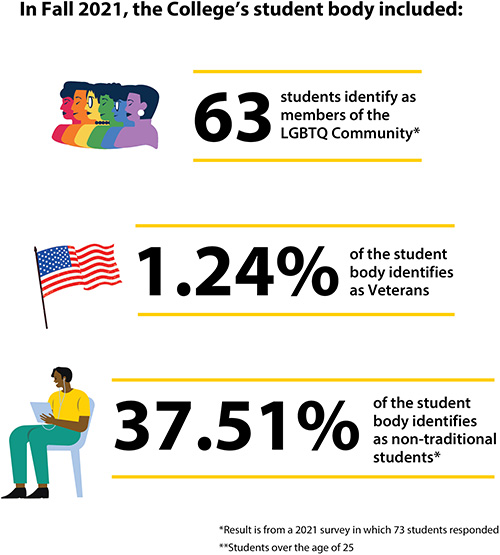 |
In Fall 2021, the College’s student body included: 37.51% of the student body identifies as non-traditional students [2] |
|
During the 2021-2022 academic year, 716 students were registered with the Center On Disability and 572 received services. |
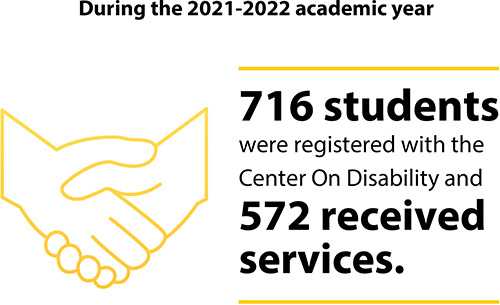 |
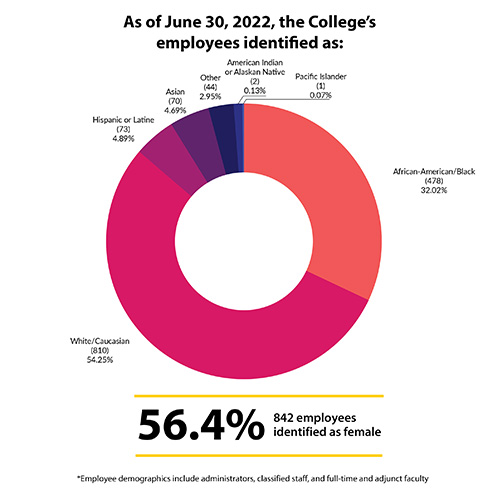 |
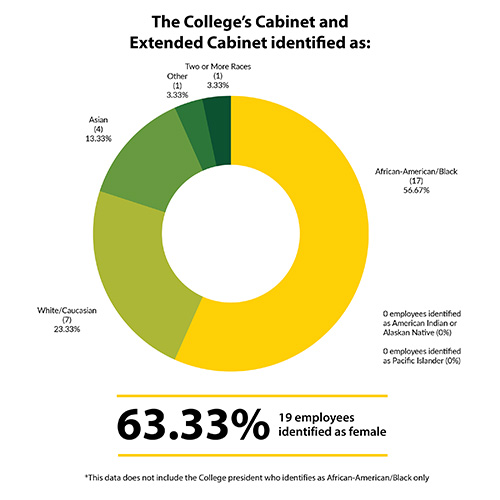 |
|
The College’s employee demographics as of June 30, 2022 are as follows [4]: 54.25% - 810 employees identified as White/Caucasian only |
The College’s Cabinet and Extended Cabinet demographics are as follows [5]: 56.67% - 17 employees identified as African American/Black only |
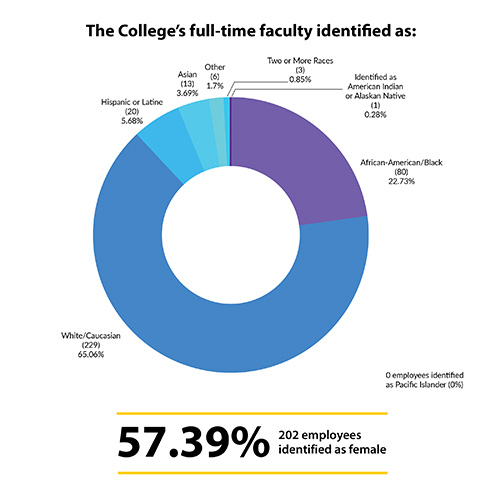 |
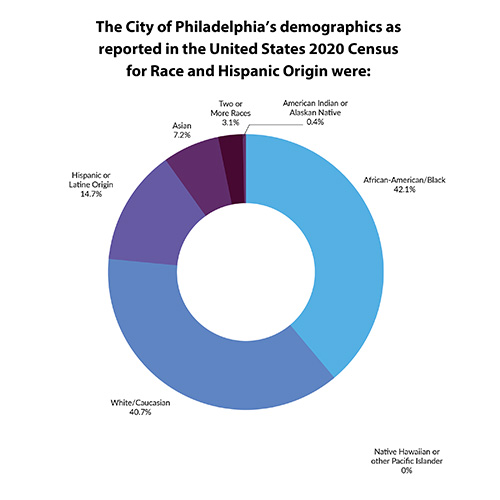 |
|
The College’s full-time faculty demographics are as follows: 65.06% - 229 employees identified as White/Caucasian only |
The City of Philadelphia’s demographics as reported in the United States 2020 Census for Race and Hispanic Origin were: 42.1 percent African-American/Black only |
To make improvements in our personnel being more reflective of our City, significant effort and thoughtful strategies will be required.
- Strategy 1: Continue to improve and streamline the recruitment, search and hiring process to enhance the potential for increasing the diversity of faculty and staff.
- Strategy 2: Continue to improve and maximize use of the Diversity Fellowship Program to increase the possibility of hiring from more underrepresented candidate pools.
- Strategy 3: Expand the use of minority-related publications and websites to broaden the search field for underrepresented applicants.
- Strategy 4: Provide the Faculty & Staff Federation $15,000 per year for its travel fund to dedicate to full-time faculty attending conferences and events where recruitment of diverse and underrepresented faculty may occur and/or where existing diverse and underrepresented faculty may engage in professional development.
- Strategy 5: Ensure that search committees are as diverse as possible by expanding the search committee structure to include faculty and staff outside of the prospective department when necessary.
- Strategy 6: Ensure that each hiring committee receives non-discrimination and anti-bias training. For full-time faculty hiring committees, the DEI Director or the DEI Director’s appointee will serve as voting member of the Hiring Committee.
- Strategy 7: Work to ensure that searches are conducted in a timely fashion to provide the best possible opportunities to retain underrepresented candidates throughout the search process.
- Strategy 8: Complete an annual review of the College’s Affirmative Action Plan to ensure the College is meeting its goals.
Objective B: Improve practices that support the success and retention of a diverse workforce.
- Strategy 1: Engage all faculty in mentoring newly hired faculty within respective departments. Build mentoring components into department and program duties that offer recognition and rewards.
- Strategy 2: Provide and encourage professional development support opportunities to new employees (faculty and staff) as well as encourage participation in skill-building training.
- Strategy 3: Actively monitor and report on turnover rates for faculty and staff by gender, race/ethnicity and any other voluntarily disclosed protected status (e.g., disability, LGBTQ, and veterans), as well as area of the College. Take appropriate steps for improvement when necessary.
- Strategy 4: Collect and assess data focusing on why employees from underrepresented groups leave our workforce and use the data to develop/revise retention strategies. Include employees from underrepresented groups in the development/revision of retention strategies.
- Strategy 5: Conduct a race and gender pay equity study among administration, calendar year faculty, academic year faculty, adjuncts, and classified and confidential staff. Bargain with Faculty & Staff Federation to address any inequities found in pay equity for unionized staff.
Objective C: Improve practices that support the inclusion of a diverse workforce
- Strategy 1: Ensure that key College committees have diverse representatives and include individuals of different races, genders/gender identities, ethnicities, sexual orientations, ages, abilities/disability, and other underrepresented groups.
- Strategy 2: Support affinity/alliance groups with use of College resources and funding for professional development and events.
- Strategy 3: As noted under Objective A, provide Faculty & Staff Federation with $15,000 for year for its travel fund to allow full-time faculty to attend conferences and events where faculty from diverse and underrepresented groups may be recruited and/or where existing diverse and underrepresented faculty may partake in professional development.
RESOURCES: Departments and Divisions may consult with Leila Lawrence, Director of Diversity, Equity, and Inclusion & Title IX Coordinator and Lisa Hutcherson, Associate Vice President of Human Resources, and Gold Enterprises, LLC. in the development of its plans.
Goal 2: Become an Anti-Racist College and fully implement anti-racist training for all administrators, staff and faculty
Objective A: To educate the College on what it means to be an anti-racist.
- Strategy 1: Engage an anti-racist consultant to provide training on being an anti-racist.
Objective B: Develop and disseminate anti-racist curricula, faculty development and professional development and training for various constituents across the College.
- Strategy 1: Make anti-racist training a requirement like sexual harassment training.
- Strategy 2: Make anti-racist training accessible during Professional Development Week.
- Strategy 3: Pay adjuncts to attend anti-racist training.
Objective C: Ensure the institution is upholding anti-racist ideals.
- Strategy 1: Review and update policies, collective bargaining agreements, and various procedures to meet the goals of being an anti-racist institution, and to ensure that policies are not disparately impacting persons of color.
Goal 3: Implement college policies that promote equitable outcomes in the classroom and all other areas and aspects of the college experience with the goal of increasing equitable graduation and pass rates for all students.
Objective A: Ensure that college current policies that affect classroom outcomes are designed to promote equitable outcomes.
- Strategy 1: Review policies that affect classroom outcomes (attendance, grade appeals, student complaints, etc.).
- Strategy 2: Analyze outcome data connected to these policies to determine whether student graduation and pass rates are equitable for all students.
- Strategy 3: Support collaboration among faculty and in other areas of the College to develop innovative strategies that strengthen the pipeline from developmental education to address the equity gaps across the College in programming, and to ensure that all students are exposed to a broad spectrum of career areas.
Objective B: Develop policies that will increase equitable graduation and pass rates for all students.
- Strategy 1: Impanel a committee to analyze graduation and pass rates and identify potential policies that will assist in closing the gaps in these rates.
- Strategy 2: Partner with College offices that address the needs of the diverse student population to assist in the creation of policies that will increase equitable graduation and pass rates for all students: Center On Disability; Center for Male Engagement; I Am More; Equity Coaches; MarcDavid LGBTQ Center; Veterans Resource Center; Student Transition Success Programs; Faculty Center for Teaching and Learning; Institute for Community Engagement and Civic Leadership; Women’s Advocacy Center and the Institute for Community Engagement and Civic Leadership.
Goal 4: Encourage the use of diverse, accessible, and inclusive course materials.
Objective A: Review and develop materials which promote diversity and inclusivity across the curriculum.
- Strategy 1: Create a local course inventory of materials by reviewing existing coursework to identify courses that already achieve the objective.
- Strategy 2: Increase the number of courses with diversity-related content, and increase the use of diverse content in existing courses.
- Strategy 3: Create a committee that will assist faculty across the disciplines in identifying and implementing diverse and inclusive course materials.
- Strategy 4: Create a recognition system that will highlight courses that include the use of diverse, accessible, and inclusive course materials.
- Strategy 5: Encourage faculty to incorporate speakers from underrepresented groups into their curriculum.
- Strategy 6: Encourage faculty to commit to incorporating open access course materials and formats to eliminate financial barriers for students.
Goal 5: Increase participation of minority, disabled, and/or women-owned suppliers to fulfill College’s procurement needs.
Objective A: Actively Engage Minority, Women and Disabled Business Enterprise (“MWDBE”) suppliers
- Strategy 1: Develop an information strategy, such as seminars and easily accessible website information, to inform minority, women, and disabled businesses of the certification procedure, and increase MWDBE awareness of the bidding process at the College.
- Strategy 2: Engage with local agencies with MWDBE membership to connect with women, minority, and disabled business suppliers; encourage members to bid for College projects and services.
- Strategy 3: Partner with Goldman Sachs 10,000 Small Businesses and Power Up Your Business to identify MWDBE suppliers.
- Strategy 4: Participate in City of Philadelphia initiatives to identify MWDBE suppliers.
Objective B: Increase use of MWDBE suppliers by College employees and contractors.
- Strategy 1: Engage College leadership in strategies to increase the recruitment of diverse suppliers.
- Strategy 2: Make MWDBE list available to College employees
- Strategy 3: Require employees seeking goods and services to detail what methods they have used to seek out diverse suppliers.
- Strategy 4: Continue to require vendors to supply a diversity plan or workforce demographics in response to RFPs, and where lacking, require vendors to create a diversity plan.
- Strategy 5: Require General Contractors to regularly report on their efforts to subcontract with MWDBEs.
Goal 6: Continue to develop and implement a comprehensive system of accountability and assessment around diversity, equity, and inclusion initiatives, practices and policies.
Objective A: Ensure underrepresented groups have a voice in implementing the overall DEI goals for the College.
- Strategy 1: Appoint employee and student representatives from the Student Government Association, other student groups and students from throughout the College to serve on the President’s Diversity, Equity and Inclusion Council.
- Strategy 2: Expand the role of the President’s Diversity, Equity and Inclusion Council to include serving as “ambassadors” to the College departments in implementing DEI strategies and assessing their outcomes.
- Strategy 3: Create a budget for and support various affinity of alliance groups for underrepresented faculty and staff.
Objective B: Regularly assess and report on campus climate and diversity programming, educational efforts, training, and visibility.
- Strategy 1: Assess diversity efforts and performance by departments and divisions by requiring annual reports from each division regarding their efforts to achieve diversity plan goals.
- Strategy 2: Use regularly collected assessment data to inform, highlight successes of, and (as needed) enhance diversity programming, services and opportunities.
- Strategy 3: Include questions related to diversity, inclusion and college climate in the exit interview process. Regularly report on findings to relevant campus officials.
Objective C: Establish and monitor systems within the College for generating feedback from students, faculty, and staff pertaining to diversity.
- Strategy 1: Survey students, faculty and staff perceptions of the College’s commitment to various aspects of diversity on a regular basis.
- Strategy 2: Collect, analyze, and disseminate diversity data in order to track the College’s progress toward goals.
Objective D: Hold Division and Department units responsible for supporting progress toward established Goals and Objectives.
- Strategy 1: Require annual reports from divisions regarding progress on achieving diversity goals.
- Strategy 2: Include diversity criteria as part of each employee’s performance evaluation.
Objective E: Strengthen College structures that support diversity
- Strategy 1: Develop a system for coordinating diversity programming to minimize scheduling conflicts and to maximize collaborations and campus awareness of relevance to classroom courses.
- Strategy 2: Review and, as needed, revise and/or add diversity-related committees to ensure effective implementation of diversity goals.
- Strategy 3: Review the flow of diversity work between committees, divisions, and departments.
- Strategy 4: Work to ensure there is a diversity representative or advocate on all College committees or planning groups.
- Strategy 5: Continuously review and evaluate College policies and procedures to ensure consistency of fair treatment and compliance with diversity and non-discrimination commitments.
Objective F: Develop and strengthen partnerships with diverse communities and groups locally, nationally, and internationally.
- Strategy 1: Identify and engage local, national, and partners with international backgrounds as diversity experts as presenters for College programming.
- Strategy 2: Identify and encourage College engagement in community service.
- Strategy 3: Establish partnerships with corporations and other institutions to collaborate on issues related to the identification and implementation of effective diversity management practices.
[1] Divisions and Department Units will report to their respective Vice Presidents on their progress toward the established Goals and Objectives of this Diversity Strategic Plan.
[2] Students over the age of 25.
[3] Result is from a 2021 survey in which 73 students responded.
[4] Employee demographics include administrators, classified staff, and full-time and adjunct faculty.
[5] This data does not include the College president who identifies as African-American/Black only
